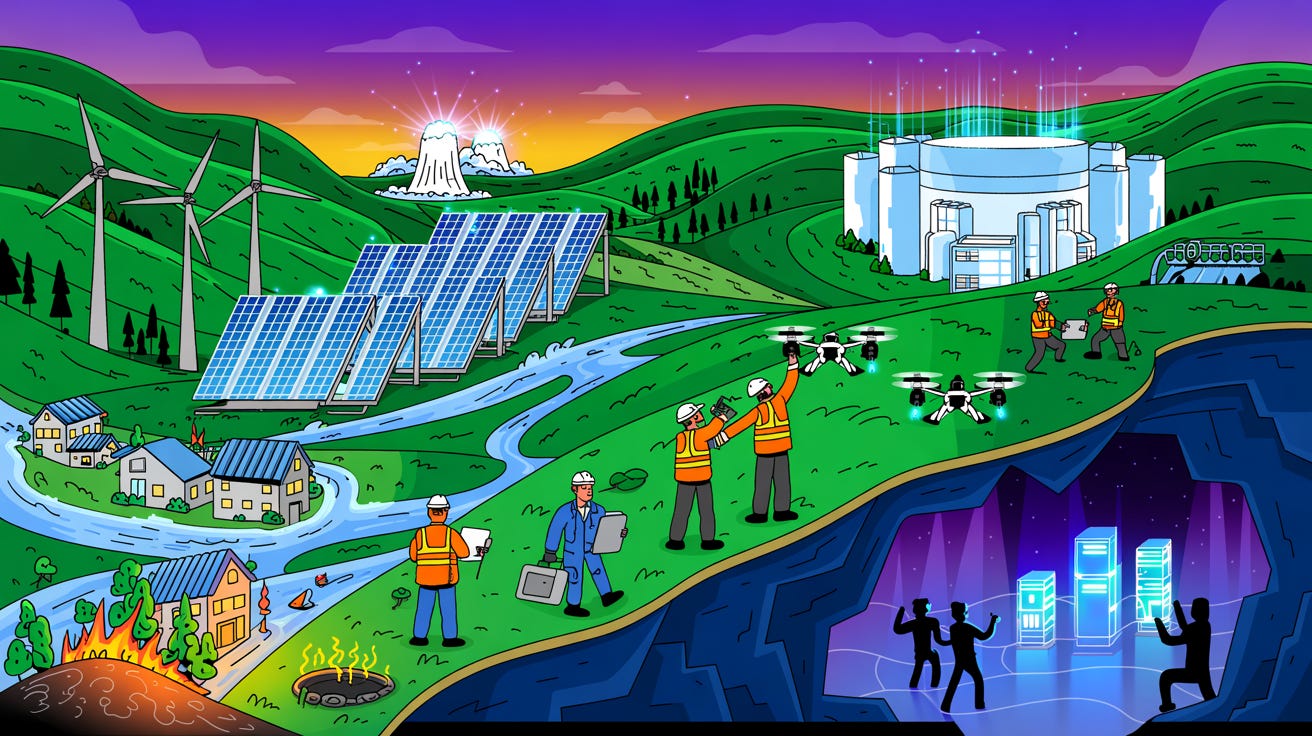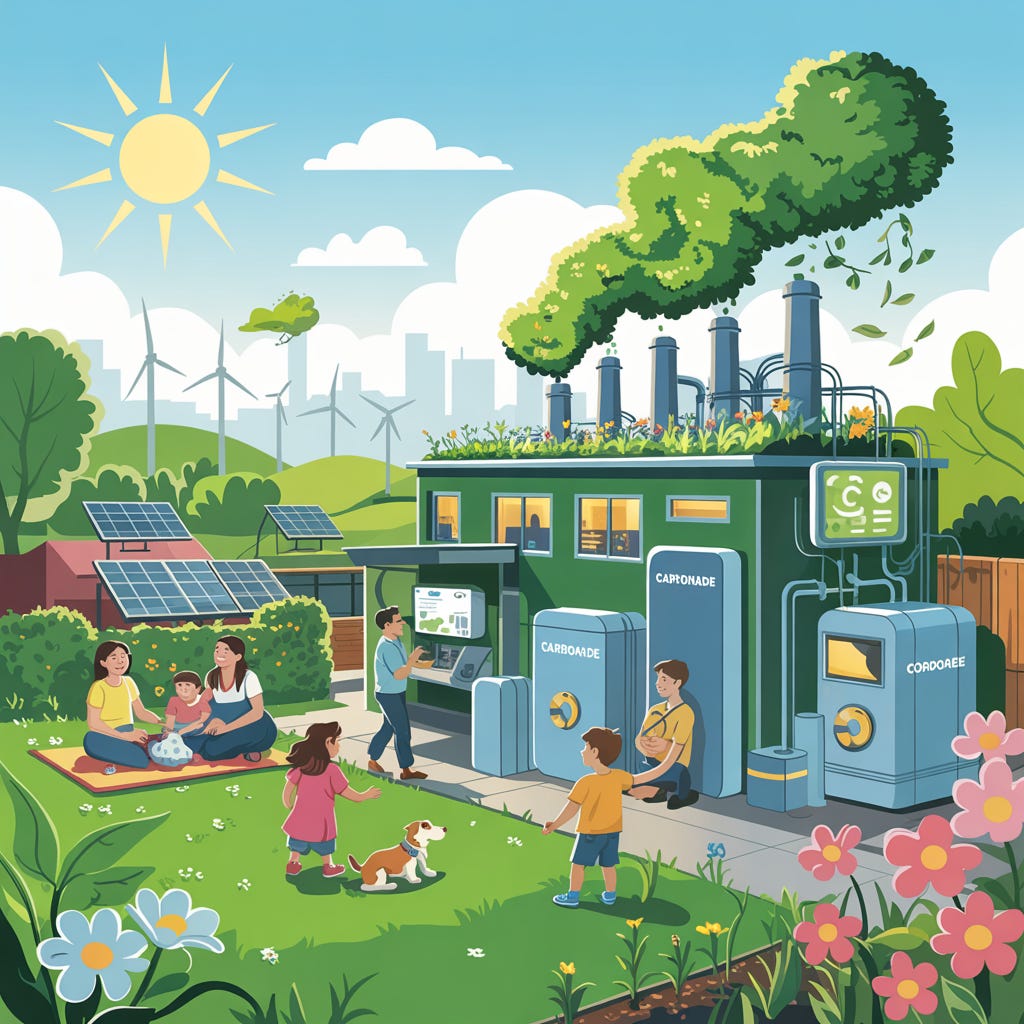The Time Machine: Are You Sure It's Not Too Cold To Build an AI Factory in the Arctic?🥶
Insurers lose a lot of money thanks to extreme weather, Norway is building an AI factory in the Arctic, and Carbonade is saving you the need to store your carbon
Happy Saturday! Welcome to the time machine, where we look at the past week and try to pretend things are normal.
The DeLorean is in the shop this weekend, so we’ll have to use our time travel-equipped second hand hybrid 🤷♂️
The Bigger Things
Insurance Market Sees Historic Losses Due to Climate Change💹:
What Happened? Reinsurer Gallagher Re recently issued a pretty crazy report that reviews of insured assets losses in the first half of 2025. In short, the report showed losses of $84B globally, the highest since 2011. 90% of losses came from severe storms, wildfires and other types of extreme weather. California’s Palisades fires accounted for nearly half of the losses, and 2025 is expected to end with losses north of $100B.
Why Care?🤷♂️ If you pay any kind of insurance premium, or are an insurer - you have to worry. The Insurance industry is undergoing a meaningful reconfiguration, with climate change upending insurance fundamentals and turning many previously insured assets - uninsurable. This report joins countless articles about a growing club of places that are uninsurable: Florida, Texas, California and many other states are increasingly becoming Insurance Deserts. The Insurance industry will have to cope with the changing reality and adopt new business models, rethink coverage or change the nature of insurance altogether.
India Reaches 50% Renewable Energy Capacity 5 Years Ahead of Target☀️:
What Happened? India, a rising global power, has announced it has reached its goal of supplying 50% of its energy capacity from renewable sources, five years ahead of schedule. That’s actually pretty impressive.
Why Care? 🤷♂️ Because it’s a big deal, that’s why. We usually hear of delays in meeting goals, not the other way around. This milestone may help India gain points on the world stage, invite additional global investments and transform its economy and society. If continues, this trends will let India use its economy as a tool of geopolitical competition and a way to promote its ambition to rise to global prominence and reshape its image, from a global back-office to a leader.
Brookfield and Google Sign Historic Hydropower Deal🌊:
What Happened? In this weekly edition of “Tech Giants Want Lots of Power”, Google has signed a historic deal with alternative asset manager Brookfield. The agreement allows Google to purchase up to 3,000 MW of power from existing hydropower facilities (that’s equivalent to power 2.4 million homes simultaneously, for reference) to power its data centers.
Why Care?🤷♂️ This framework agreement is the largest deal to purchase power from hydroelectric facilities, and allows Brookfield to continue to maintain, upgrade and expand its hydro facilities. The deal is another instance where tech giants secure their ever-growing energy needs from renewable, no/low carbon sources. Despite the Trump administration’s continued efforts to throttle renewables, tech giants are applying a real “all of the above” energy strategy, counting of both renewables and fossil fuels, instead of just the latter.
The Smaller Things
New Reports Warn of Climate Risks to Data Centers 🖥️:
What Happened? Two recently-issued reports warn that data centers are set to experience a growing set of physical risks as a result of climate change. These include floods, storms and water shortage. Also, the soil underneath may go rogue. By 2050, 6% of US data centers could be high risk, and up to 80% of the world’s top hubs may face serious heat hazards. Geez…
Why Care?🤷♂️ If you have to ask why this matters, you haven’t been living on this planet for the past few years. Data centers are the AI age’s backbone, and it seems like everyone is building one these days. Climate chaos just might derail our plans to AI everything, as disruptions are likely to grow and insurance costs are expected to quadruple by 2050. Will we see AI subscription prices soar? Will we see slower growth? Or maybe collapse of the quest for Superintelligence? I guess we’ll find out.
Columbia University Doesn’t Think OBBBA Will Stop Renewables🟩:
What Happened? A new paper by Columbia Business School argues that OBBBA, recently signed into law, cannot stop the green wave of renewables. The paper argues that although US manufacturing will take a hit and China will benefit from OBBBA’s passing, renewables are still the big cheese 🧀: Solar and Wind are economically superior to alternatives, and Nuclear and Geothermal have actually gained some benefits from the bill.
Why Care? 🤷♂️ Anxiety of what will happen to renewables post OBBBA is literally everywhere (with good reason). Still, if this article is right, it may not be all over for the US’s renewable future. Things are not good, but they may just be ok at the end.
China Quietly Puts Quotas on Rare Earth Minerals🪙:
What Happened? China has issued its 2025 quotas for Rare Earth minerals, but this time it’s being cagey about them. Rare Earth minerals quotas are nothing new, but usually China announces them outright. This year, China asked companies in this sector to keep a tight lid on the exact quotas for “security reasons”, leaving importers guessing.
Why Care? 🤷♂️ Rare Earth minerals, as we’ve seen previously, are used in manufacturing of critical components in defense and advanced manufacturing contexts. China, controlling much of the mining and processing of these critical minerals, is increasingly using controls over them as a geopolitical weapon to advance its goals. In our context, China’s quotas dramatically impact the ability of entire regions to decarbonize their economies and provides China will an upper hand.
The Cooler Things
The North Remembers (AI Infrastructure): Building beyond the Wall? Looks like Norwegian investor Aker is joining Google and others in setting up AI infrastructure in the remote areas of Norway. The investment firm will build a mysterious AI factory along the coastal town of Narvik, tucked deep in the Arctic Circle. Now, as you know, I’m a bit obsessed with the Arctic, so naturally I’m excited. Why?
Aker are building this factory because… it needs the cold. AI is power-hungry, and often requires cooling. Norway is cold. It’s that simple.
Aker’s gambit is part of a larger trend to build infrastructure in the Arctic, which is currently a big empty block of (disappearing) ice 🧊. Projects like Aker’s stand to bring additional development and turn the Arctic, for better or for worse, into an economically active zone.
AI-ify the News
As always, here’s an AI-generated picture that should somehow summarize the news. Whether it’s successful or not is up to you to decide.
Carbonade
You're a CEO of a large enterprise, a titan of industry. You're the talk of the town. It just so happens that your business is… well, hard to abate. Maybe you're in aviation (mom always wanted you to be a pilot✈️), or shipping (ahoy, captain! 🚢). Maybe you have a large factory. Now, you've been in the business long enough to get into that CO2 capture business. They say it's good for business and for the planet.
Capturing CO2 these days is easy. But what are you going to do with it? You're not in the business of storing carbon! Most companies just give up or stick with expensive, inefficient processes. But not you. You're not giving up on carbon without a fight.
Lucky for you, you read this blog Substack. We've got your back.
Meet Carbonade.
Carbonade has developed a groundbreaking solution that transforms captured CO2 directly into valuable building blocks of numerous high-demand products. Whether you need sustainable aviation fuels (SAF), e-methanol for shipping, or other carbon-based chemicals, Carbonade's technology provides you with a green solution while skipping the most expensive step in making carbon useful.
Carbonade helps hard-to-abate sectors get more value from carbon by giving you...
40% greater energy efficiency than conventional CO2 conversion solutions
An ambient-temperature operation that reduces system complexity, offers load flexibility to match variable renewable energy supply
Delivers superior selectivity, producing targeted products directly and eliminating costly downstream separation processes.
Controlled syngas production (CO and H2) at precise ratios for downstream sustainable fuel manufacturing
Plug-and-play system requiring no changes to existing infrastructure
With hard-to-abate sectors contributing roughly 30% of GHG emissions, the pressure to do something about it is mounting up. That is why Carbonade couldn't be more timely. By turning what was previously considered waste into valuable resources, they're addressing one of the most critical bottlenecks in our transition to net-zero.
To me, Carbonade not only helps businesses abate emissions where it matters most, but also represents the Reconfiguration of heavy industries and carbon markets. The easier and cheap abating carbon becomes, the faster decarbonization takes place, effectively reconfiguring major parts of the economy, while opening up secondary and tertiary markets based on the ability to turn carbon into something useful.
Check them out here.
That’s it for this edition of News Reconfigured.
Stay tuned for my new hot take on Tuesday, and see you soon next week!
…oh, and don’t forget to subscribe - it would mean a lot! 🔽









Always a joyful way to keep us updated on the cool stuff!